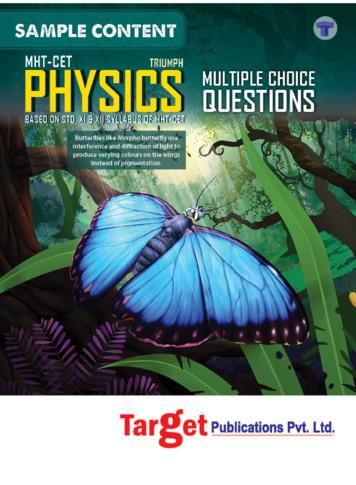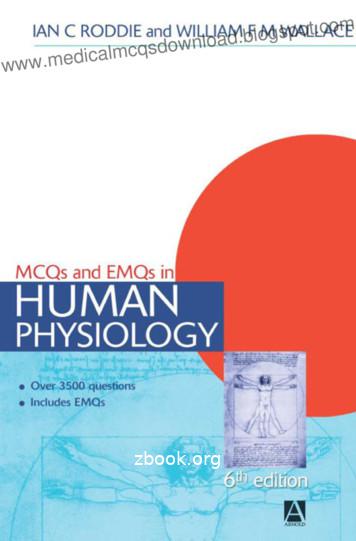MHT-CET Triumph Biology MCQs (Based On XI & XII Syllabus .
MPLSAECOTENTN
MHT-CETNTWritten in accordance with the latest MHT-CET Paper Pattern which includes topics based on Std. XII Sc.and relevant chapters of Std. XI Sc. (Maharashtra State Board)TRIUMPHNSalient FeaturesQUESTIONSTEBIOLOGYMULTIPLE CHOICEMHT-CET Paper Pattern.O Includes chapters of Std. XII and relevant chapters of Std. XI as per latest Exhaustive subtopic wise coverage of MCQs.C Quick review provided for each chapter. Various competitive exam questions updated till the latest year. Includes solved MCQs upto MHT-CET 2018.E Includes solved MCQs from NEET 2016, 2017 and 2018.PL Evaluation test provided at the end of each chapter.SAMScan the adjacent QR code or visit www.targetpublications.org/tp12741to download Hints for relevant questions and Evaluation Test in PDFformat.Printed at: Print Vision, Navi Mumbai Target Publications Pvt. Ltd.No part of this book may be reproduced or transmitted in any form or by any means, C.D. ROM/Audio Video Cassettes or electronic, mechanicalincluding photocopying; recording or by any information storage and retrieval system without permission in writing from the Publisher.P.O. No. 124074TEID: 12741 JUP
CONTENTSr. No.TextbookChapterNo.Chapter NamePage No.Std. XI11Diversity in Organisms23Biochemistry of Cell36Plant Water Relations and Mineral Nutrition47Plant Growth and Development59Organization of Cell610Study of Animal Tissues712Human Nutrition813Human RespirationNT119TE64NStd. XII4081981201321Genetic Basis of Inheritance149102Gene: Its Nature, Expression and Regulation168113Biotechnology: Process and Application198124Enhancement in Food Production214135Microbes in Human Reproduction in Plants28317918102021CE310Origin and Evolution of Life32911Chromosomal Basis of Inheritance35412Genetic Engineering and Genomics37513Human Health and Diseases38514Animal Husbandry407M22Organisms and Environment IPL19O915Circulation4162416Excretion and Osmoregulation4402517Control and Co-ordination4632618Human Reproduction5052719Organisms and Environment II544Model Question Paper - I565Model Question Paper - II571SA23Note: Questions of standard XI are indicated by ‘*’ in each Model Question Paper.
TextbookChapter No.Diversity in OrganismsCarolus Linnaeus (1707-1778)NT011.0Introduction1.1Diversity in Living Organisms1.2Systematics: Taxonomy, Taxonomic Hierarchy andTESyllabusBinomial NomenclatureFive Kingdom System of Classification1.4Lichens1.5Viruses and ViroidsN1.3COCarolus Linnaeus proposed the Binomialnomenclature system in 1758 which is asignificant contribution to plant taxonomyand is widely accepted throughout theworld.Quick ReviewTaxonomic hierarchyPLEKingdom Division / Phylum Class Sub-class Series Order Family Genus SpeciesFive kingdom classificationSAMKingdom Monerae.g. tesKingdom ProtistaKingdom Fungie.g. Mucor,Rhizopus,PenicilliumPlant like Protists Animal like Protists Fungi likeProtistse.g. Dinoflagellates, e.g. Amoeba,e.g. SlimeParamoeciumDiatomsmouldsKingdom GymnospermsAngiospermsEuglenoidse.g. Euglena1
MHT-CET Triumph Biology (MCQs)LichensFungal ichens Foliose-lichens Fruticose-lichensNTAscolichensExternal formVirusesAnimal viruse.g. Influenza virus,HIV1.0IntroductionSum total of all the reactions occurring in thebody of an organism is called(A) bioreaction(B) metabolism(C) expansion(D) regeneration2.is the defining property of livingorganisms.(A) Reproduction(B) Growth(C) Consciousness (D) Increase in weight8.Branch of biology dealing with identification,nomenclature, description and classification is(A) biogeography(B) eugenics(C) ecology(D) taxonomyO1.The term classification was coined by(A) Linnaeus(B) A. P. de Candolle(C) Darwin(D) R.H. WhittakerN7.Classical ThinkingBacteriophagee.g. phageTEPlant viruse.g. Tobacco mosaicvirus (TMV)C9.Living organisms are(A) self replicating(B) capable of responding to external stimuli(C) self regulating interactive systems(D) all of above10.Three domain system includes(A) Plantae, Animalia, Prokaryotes(B) Monera, Protista, Eukaryotes(C) Archaea, Bacteria and Eukarya(D) Bacteria, Plantae and Animalia11.Kingdom animalia is included under domain(A) Archaebacteria (B) Bacteria(C) Eukarya(D) None of these12.The taxonomic hierarchy was established by(A) John Ray(B) Lamarck(C) Aristotle(D) Carolus Linnaeus13.Descending arrangement of categories isknown as(A) classification(B) taxonomy(C) systematics(D) hierarchyPLE3.1.1Diversity in Living OrganismsWhat is the approximate number of plants andanimal species present on earth?(A) 2 – 10 million(B) 3 – 20 million(C) 4 – 30 million(D) 5 – 30 millionM4.Systematics: Taxonomy,Taxonomic Hierarchy and BinomialNomenclatureSA1.2Three domain system was introduced by(A) Carl Woese(B) Hackel(C) Whittaker(D) H.J. Lam5.The study of diversity of organism is called as(A) taxonomy(B) systematics(C) classification(D) nomenclature14.The term ‘taxon’ was coined by(A) Lamarck(B) H. J. Lam(C) Linnaeus(D) John Ray6.Who among the following is associated withsystematics?(A) Watson(B) Robert Hooke(C) Linnaeus(D) Dixon15.A group of organisms used to represent aconcrete unit of classification is(A) rank(B) order(C) taxon(D) genus2
Chapter 01 : Diversity in OrganismsThe basic unit upon which the system ofclassification is constructed is the(A) species(B) order(C) family(D) class19.The species refers to a group of(A) individuals with some similarity(B) similar individuals with common ancestry(C) interbreeding members(D) both (B) and (C)Concept of species was remodified as closelyresembling interbreeding population by(A) Theophrastus(B) Darwin(C) Linnaeus(D) Ernst Mayr21.Mayr’s biological concept of species is mainlybased on(A) morphological traits(B) reproductive isolation(C) modes of reproduction(D) morphology and reproductionEPLMMorphological concept of species was given by(A) H.J. Lam(B) Charles Darwin(C) Carolus Linnaeus(D) A. P. de CandolleA group of organisms that can interbreedunder natural conditions is called(A) morphospecies (B) biospecies(C) polyspecies(D) indicaSA23.24.25.Which one of the following covers a greaternumber of organisms?(A) Species(B) Family(C) Class(D) Kingdom28.Dicotyledonae is a(A) category(C) order29.30.Which of the following is NOT a taxon butcategory?(A) Division(B) Dicotyledons(C) Angiosperms(D) PolypetalaeBasic unit of classification is(A) genus(B) class(C) species(D) order(B)(D)classkingdomTaxonomic category ‘order’ comes in between(A) genus and species(B) genus and family(C) family and series(D) division and classThe smallest taxon is(A) class(C) species(B)(D)ordergenus31.A group of closely related families whichresemble in major characters are includedunder one(A) class(B) genus(C) order(D) division32.A group of plants or animals with similarcharacters of any rank is(A) species(B) genus(C) order(D) taxon33.Taxon ‘Mangifera’ denotes(A) genus(B)(C) division(D)C20.22.27.O18.In classification, the category present belowfamily is(A) genus(B) species(C) order(D) classNTIn biological terminology, a group of similarorganisms which are capable of inter-breedingand forming fertile offspring is called(A) species(B) tribe(C) genus(D) family26.TE17.Which is the CORRECT sequence intaxonomic hierarchy?(A) Class species order family division(B) Division order class family genusspecies(C) Division class order family genusspecies(D) Species class order division familyN16.speciesclass34.Angiospermae and Gymnospermae are(A) kingdom(B) order(C) division(D) family35.In ‘Solanum tuberosum’, tuberosum denotes(A) genus(B) species(C) family(D) tuber36.Binomial nomenclature is published in(A) Philosophia Botanica(B) Species Plantarum(C) Systema Naturae(D) Historia Naturalis3
MHT-CET Triumph Biology (MCQs)Mention of author’s name after the speciesname is called(A) citation(B) translation(C) recognization(D) publication39.Which name is written correctly?(A) Apis indica(B) hibiscus esculentus(C) Mangifera indica(D) benghalensis Ficus40.Botanical name of potato is(A) Ipomea batatas(B) Solanum tuberosum(C) Mangifera indica(D) Azadirachta indicaHaeckel classified the organisms intokingdoms.(A) two(B) three(C) four(D) five48.Two kingdom classification system was givenby(A) Carl Linnaeus(B) Huxley(C) Whittaker(D) John Ray49.Whittaker proposed the system ofclassification.(A) two kingdom(B) three kingdom(C) four kingdom(D) five kingdom43.Which of the following is a wrong statement?(A) Vernacular names may be misleading.(B) Vernacular names are not universal.(C) Vernacular names are short and easy tofollow.(D) Vernacular names indicate phylogeny,i.e. evolutionary history of organisms.EPLMSAWhittaker could not give place to one of thefollowing in five kingdom classification.(A) Cyanobacteria(B) Slime moulds(C) Virus(D) AmoebaOWhen a single species is described underdifferent names by different authors, thenthese names are called as(A) antonyms(B) synonyms(C) holotype(D) varietyC42.4Five Kingdom System of Classification47.51.The scientific name of sunflower is(A) Hibiscus rosa-sinensis(B) Mangifera indica(C) Helianthus annuus(D) Sida acuta45.1.350.41.44.Prior to the proposal of binomial, the plantnames were(A) Polynomials(B) Mononomials(C) Trinomial(D) TetranomialsN38.46.NTBinomial nomemclature systems follows rulessuch as the(A) specific name should begin with acapital letter.(B) scientific names must be printed in italics.(C) name of the author cannot be written inabbreviated form.(D) name of the species cannot be repeatedeven if the genera are different.TE37.Which of the following is a heterogeneous group?(A) Family, Genus, Order(B) Division, Class, Species(C) Hibiscus, Genus, Species(D) Hibiscus, Sorghum, CycasInternational code of binomial nomenclatureapplies to(A) viruses(B) plants(C) animals(D) both (B) and (C)In the five kingdom classification, themembers in Kingdom Animalia areeukaryotic, heterotrophic and(A) unicellular(B) multicellular(C) photobiont(D) non motile52.Out of the following, which system shows thephylogenetic relationship between organisms?(A) Two kingdom classification(B) Five kingdom classification(C) Three kingdom classification(D) All of these53.The five kingdom classification is based on(A) complexity in cell structure(B) mode of nutrition(C) complexity of organism’s body(D) all of these54.Primitive nucleus, DNA without histoneproteins, absence of membrane bound cellorganelles are the characters of Kingdom(A) Protista(B) Monera(C) Fungi(D) Plantae55.Blue green algae belong to kingdom(A) Plantae(B) Protista(C) Fungi(D) Monera56.Thiobacillus is a(A) Photoautotroph(C) Protist(B)(D)ChemoautotrophHeterotroph
Chapter 01 : Diversity in OrganismsOrganisms of kingdom Monera shows(A) Chloroplasts(B) Mitochondria(C) Rigid cell wall (D) All of these58.In five kingdom classification, protistacomprises of(A) both uni and multicellular microscopiceukaryotes(B) unicellular eukaryotes(C) all prokaryotes(D) multicellular eukaryotes67.Some fungi have no cross walls in theirhyphae. These hyphae are called(A) septate(B) non-septate(C) septum(D) all of these68.Which cell organelle is absent in Kingdom fungi?(A) Chloroplast(B) Ribosome(C) Nucleus(D) Golgi body69.Multicellular eukaryotic decomposers belongto kingdom(A) Animalia(B) Fungi(C) Plantae(D) MoneraNT57.In kingdom Protista, the locomotory organs are(A) cilia(B) flagella(C) pseudopodia(D) all of these70.are also called as Sac fungi.(A) Ascomycetes(B) Basidiomycetes(C) Phycomycetes(D) Deuteromycetes60.Protists obtain their food as(A) photosynthesizers only(B) chemosynthesizers(C) heterotrophs only(D) both (A) and (C)71.Deuteromycetes are also called as .(A) bracket fungi(B) algal fungi(C) ascocarps(D) imperfect fungi63.64.NMulticellular eukaryotic consumers belong toKingdom(A) Fungi(B) Protista(C) Plantae(D) AnimaliaOChrysophytes include(A) diatoms(B)(C) dinoflagellates (D)Amoeba and Paramoeciumkingdom(A) Animalia(B)(C) Monera(D)Plants are(A) unicellular, eukaryotic, photosyntheticorganisms(B) multicellular, eukaryotic, heterotrophicorganisms(C) multicellular, eukaryotic, photosyntheticorganisms(D) unicellular prokaryotic organisms75.Vascular tissues are absent in(A) algae and bryophyta(B) bryophyta and pteridophyta(C) algae and gymnosperm(D) bryophyta and gymnosperm76.Which is NOT a correct match?(A) Fungi Penicillium(B) Monera bacteria(C) Protista yeast(D) Plantae mossdesmidsall of theseare included inProtistaFungiWhich of the following is CORRECTregarding protists?(A) They reproduce by asexual or sexualmethod.(B) AmoebaandParamoeciumareautotrophic.(C) They are multicellular, prokaryotic andmostly aquatic.(D) Trichophyton, slime moulds, Euglenaare some protists.The kingdom of true multicellular producers is(A) Animalia(B) Plantae(C) Monera(D) Protista74.Golden algaeEuglenoidsThe Kingdom which is a link betweenprokaryotes and multicellular eukaryotes is(A) Protista(B) Monera(C) Plantae(D) AnimaliaSA66.73.CDesmids are also called as(A) Red algae(B)(C) Ascocarps(D)M65.Which one of the following is a member ofprotista?(A) Nostoc(B) Frog(C) Slime moulds(D) MushroomE62.72.PL61.TE59.1.477.Lichenswas first to use the word ‘lichen’.(A) Theodor Diener(B) Theodor Schwann(C) Linnaeus(D) Theophrastus5
PLEMSAOCNTENT
MHT-CET Triumph Biology (MCQs) 1.0 Introduction 1. Sum total of all the reactions occurring in the body of an organism is called (A) bioreaction (B) metabolism (C) expansion (D) regeneration 2. _ is the defining property of living organisms. (A) Reproduction (B) Growth (C) Con
MHT-CET Syllabus. Exhaustive subtopic wise coverage of MCQs. Notes, Shortcuts, Mindbenders, Formulae provided in each chapter. Various competitive exam questions updated till the latest year. Includes MCQs from NEET 2016, 2017 and 2018. Includes MCQs upto MHT-CET 2018. Evaluation test provided at the end of each chapter.
MCQs 261-330 115 EMQs 331-340 139 6 Special senses MCQs 341-384 149 EMQs 385-394 163 7 Urinary system MCQs 395-434 171 EMQs 435-444 185 8 Endocrine system MCQs 445-501 193 EMQs 502-512 211 9 Reproductive system MCQs 513-567 219 EMQs 568-576 237 l0. General questions MCQs 577-639 245 EMQs 640-649 265 11 Sport and exercise physiology MCQs 650-686 .
MHT-CET PHYSICS TRIUMPH Scan the adjacent QR code to download Hints for relevant questions, Solutions to . For the syllabus of MHT-CET 2021, . As a first step to MCQ solving, students should start with elementary questions. Once a momentum is gained, complex MCQs
MHT-CET EXAMINATION SET-A BIOLOGY MHT-CET Test The distribution of marks subjectwise in each part is as under for each correct response. Each question has 4 choices (A), (B), (C) and (D), out of which ONLY ONE i
response key to the Common Maharashtra (MHT-CET 2019) was launched on Wednesday. The MHT CET response key is available for physics, chemistry, mathematics and biology. Step 2 "Next, candidates need to enter details to access the login, which will not apply the application and the password. 18:15 IST MHT CET 2019 Response key - You can
on the syllabus for MHT-CET 2021 till the time when this book was going to be printed and taking the fact into consideration that the entire syllabus for std. XII Science has always been an integral part of MHT-CET syllabus, this book incl
For the syllabus of MHT-CET 2021, 80% of the weightage is given to the syllabus for XII standard while only 20% is given to the syllabus for XI standard (with inclusion of only selected topics). Although the syllabus for Std. XI - XII and MHT-CET is aligned, the outlook to study the subject
Academic writing is cautious, because many things are uncertain. When we put forward an argument, point of view or claim, we know that it can probably be contested and that not everybody would necessarily agree with it. We use words and phrases that express lack of certainty, such as: Appears to Tends to Seems to May indicate Might In some .























